|
|
|
|
|
|
|
Achi-Kochi Japan
Showing many places to visit and foods to eat in Japan
|
|
|
|
|
|
|
|
|
|
|
|
|
Japan
> Themes
> History vol.3 After Samurai
|
|
|
|
|
|
|
A Hisotry of Japan
vol.3 After Samurai
( Achi-Kochi Japan )
|
|
|
|
|
|
|
|
|
|
|
|
|
( "Achi-Kochi" in Japanese means "Here and there" in English. )
Meiji Period
In A.D.1867, Yoshinobu Tokugawa, the 15th and the last Shogun of Tokugawa Shogunate returned the political power to the Emperor and the Meiji Government was organised by some feudal domains such as Satuma ( now Kagoshima Prefecture ) and Choshu ( now Yamaguchi Prefecture ). Then Meiji Period started in A.D.1868.
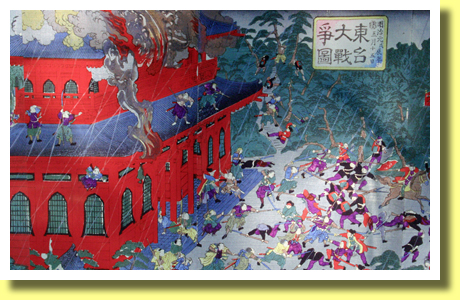
However the new government was not satisfied with Tokugawa clan ruling large domains while the supporters of Tokugawa were not satisfied as well. So Boshin War started at Toba-Fushimi, located in the south of Kyoto, where the Shogunate force was defeated and Yoshinobu Tokugawa withdrew to Edo ( Tokyo now ).
The new government sent forces to Edo. Yoshinobu Tokugawa surrendered Edo-jo Castle and confined himself in Mito. However some of Tokugawa retainers and supporters occupied Kan'ei-ji Temple located in Ueno, Tokyo where Battle of Ueno ( above ) was fought.
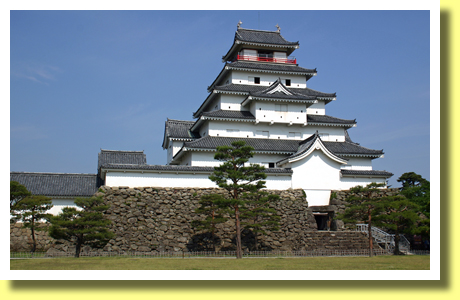
Those who supported Tokugawa retreated and there were battles here and there in the north of Japan, such as Aizu Wakamatsu, Fukushima Prefecture, Tohoku region, where Tsuru-ga Jo Castle ( above ) was heavily damaged in the battle.
Some of Tokugawa retainers establised Republic of Ezo in Hokkaido and occupied Goryokaku Fortress located in Hakodate. The soldiers of the republic surrendered in A.D.1869 and Boshin War was ended. On the other hand, from Kyoto which had been the capital city since A.D.794, the Emperor Meiji moved to Edo, which became the new capital city "Tokyo". Edo-jo Castle became "Kokyo" ( the Imperial Palace ).
Then the Meiji government worked on various reformations to enrich the country and strengthen the army. Ministries were reorganised. Taxation system was reformed. Feudal domains were replaced with prefectures. Samurai class was abolished. Chonmage ( Topknots ) were cut off. Land ownership was modernised.
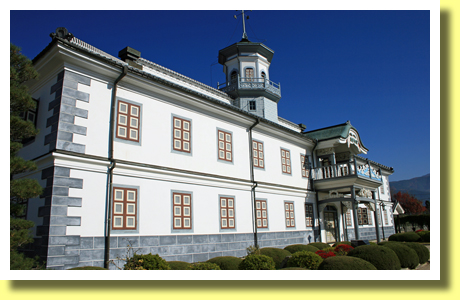
In addition, Western science and technology were introduced. Railroads and factories were built. Banks were established. The ban on Chirstianity was lifted. People ate beef and drank milk. Elementary education became compulsory and lots of school were established such as Kaichi School ( above ) which was built in Matsumoto City, Nagano Prefecture, Koh-Shin-Estu region in A.D.1876.
The Meiji government carried out military modernization and expansion.
The new army defeated samurai rebels such as the rebellion in Satsuma ( now Kagoshima Prefecture ) in A.D.1877. Japanese land and naval forces won First Sino-Japanese War ( A.D.1894-1895 ) and Russo-Japanese War ( A.D.1904-1905 ).

Above photo shows the statue of Marshal-Admiral Heihachiro Togo and Japanese Battleship Mikasa, which was the flagship of Heihachiro Togo, who was Commander-in-Chied during Russo-Japanese War and defeated Russian fleets. Battleship Mikasa is a museum ship preserved in Yokosuka City, Kanagawa Prefecture, Kanto region.
|
Taisho Period
Emperor Taisho was enthroned in A.D.1912 and Taisho Period started, through which "Taisho Democracy" Movement aroused various changes. Education raised literacy rate and people, who read more, expressed their opinions much more. Universal male suffrage was introduced though women had no right to vote for a while. It became customary that a majority party organised the cabinet.

In A.D.1914 Japan sided the Allies in World War I, during which thousands of German soldies were captured and they were imprisoned at camps in Japan. Above photo shows the site of Bando prisoner-of-war camp set up in Naruto City, Tokushima Prefecture, Shikoku region. In Bando POW camp, German soldiers formed an orchestra, which performed Beethoven's Ninth Symphony for the first time in Japan in A.D.1918.
German soldiers formed a soccer football team in Hiroshima and played a game with a Japanese team, which was the first international soccer match in Japan. Karl Juchheim, who used to be a POW in Hiroshima in A.D.1917, baked the first baumkuchen in Japan.
World War I provided Japan with the opportunities to grow economically and Japane became one of the great powers at the end of the war. In A.D.1920 the League of the Nations was founded and Japan participated the organisation as one of four permanent members of the League Council.

It was in A.D.1923 when the Great Kanto Earthquake struck Japan. The earthquake struck at lunchtime and caused fires here and there. More than 140,000 people died and a few million people lost their houses in Kanto region including Tokyo. Above photo shows Ueno Station and lots of refugees who escaped fires.
|
Showa Period
Emperor Showa was enthroned in A.D.1926 and Showa Period started. After strucked by Great Kanto Earthquake in A.D.1923, Japan was shaken by Financial Crisis in A.D.1927 and again by the Great Depression in A.D.1929. Many companies went out of business. Lots of people lost jobs. Social unrest was increased. In addition, the Treaty for the Limitation and Reduction of Naval Armament, signed in A.D.1930, dissatisfied the military.
In A.D.1931, Japanese army invaded Manchuria in Northeast China, where the puppet state of Manchuria was founded next year. However, the League of Nations recognized Manchuria as a part of China, which resulted in Japan resigning its membership in A.D.1933. However Japanese expansionists became more ambitious and the Second Sino-Japanese War broke out in A.D.1937.
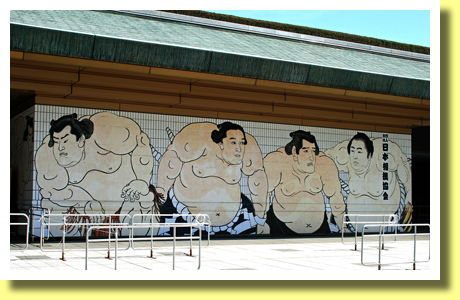
On 15th May 1932, Charlie Chaplin was watching Sumo wrestling matches in Ryogoku Kokugikan ( Ryogoku Sumo Hall - above ), Tokyo. At that time, Prime Minister Tsuyoshi Inukai was killed by naval officers, who attempted coup d'etat ( May 15 Incident ), supported by army cadets and ultra nationalistic civilians.
Though the prime minister was to welcome Chaplin, the schedule was changed. Otherwise the naval officers could have killed both of them. After killing the prime minister, the naval officers surrendered.
The incident was followed by February 26 Incident in A.D.1936. It was another coup d'etat, which was carried out by a group of army officers and more than a thousand of soldiers. Though some political leaders were killed, the coup d'etat failed. However the militarization of Japan was accelerated.

On 7th December 1941 GMT ( 8th December JST ), hundreds of Japanese aircrafts assaulted U.S. naval base at Pearl Harbor, Hawaii, U.S.A. and U.S. Pacific Fleet was damaged seriously. USS Arizona was one of U.S. battleships sunk and those who visit Pearl Harbor could see its wreck ( above ) even now. Then U.S.A. declared war on Japan, whose Axis allies, Germany and Italy declared war on U.S.A.

Japan attacked not only Hawaii but also Hong Kong, Malaya, Singapore, Guam, the Philippines and so on and occupied territories. However in A.D.1942 Japan lost the Battle of Midway, where four of Japanese aircraft carriers were sunk. Since then on, Japan lost occupied teritories one after another notwithstanding banzai charges and kamikaze attacks. Above photo shows Kamikaze Attack on USS Missouri.
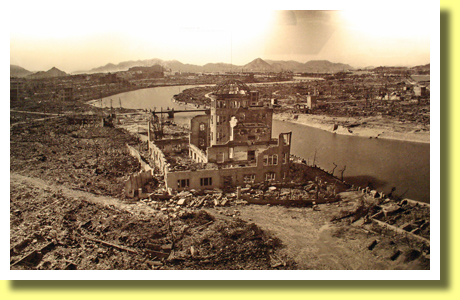
In A.D.1944, U.S. forces captured the Mariana Islands, which provided U.S. B-29 bombers with air bases to carry out strategic air strikes on
Tokyo, Osaka and other Japanese cities. Enola Gay departed Tinian, one of the Mariana Islands, to drop the first atomic bomb over Hiroshima ( above ) on 6th August 1945. Also Bockscar flew from Tinian to drop the second atomic bomb over Nagasaki on 9th August 1945. Six days later Japan surrendered.
Japan had been occupied by the Allied Powers through A.D.1945-1952, during which various reforms were carried out to demilitarize and democratize Japan. The International Military Tribunal for the Far East made hundreds of war criminals executed. The Constitution of Japan came into effect in A.D.1947, according to which the Emperor of Japan is the "symbol" of the State and of the unity of the people and play only a ceremonial role. Universal suffrage was granted not only men but also women. Article 9 of the Constitution renounces the right to wage war.
In A.D.1952 the Peace Treaty ended the Allied occupation for Japan. In A.D.1956 Japan was seated in the United Nations. Shinkansen, the bullet trains, started service in A.D.1964, when it hosted the Olympic Games in Tokyo. Its economy grew to be the second largest in the world in A.D.1968. In the same year Ogasawara Islands, which had been occupieid by U.S.A., was returned to Japan, while Okinawa was returned in A.D.1972.
|
Heisei Period and Reiwa Period
Showa Period was followed by Heisei Period which started in A.D.1989. Next year the economic bubble collapsed and Japan's Lost Decade started. In A.D.2011 Tohoku earthquake killed almost 16 thousands people and injured more than several thousands while a few thousands are still missing. Also Tsunami caused a nuclear meltdown and radiation leakage. Afterward Reiwa Period started in A.D.2019.
|
Copyright (c) 2021 Achi-Kochi Zanmai Co., Ltd.
|